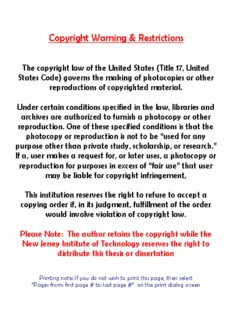
njit-etd2014-002 PDF
Preview njit-etd2014-002
Copyright Warning & Restrictions The copyright law of the United States (Title 17, United States Code) governs the making of photocopies or other reproductions of copyrighted material. Under certain conditions specified in the law, libraries and archives are authorized to furnish a photocopy or other reproduction. One of these specified conditions is that the photocopy or reproduction is not to be “used for any purpose other than private study, scholarship, or research.” If a, user makes a request for, or later uses, a photocopy or reproduction for purposes in excess of “fair use” that user may be liable for copyright infringement, This institution reserves the right to refuse to accept a copying order if, in its judgment, fulfillment of the order would involve violation of copyright law. Please Note: The author retains the copyright while the New Jersey Institute of Technology reserves the right to distribute this thesis or dissertation Printing note: If you do not wish to print this page, then select “Pages from: first page # to: last page #” on the print dialog screen The Van Houten library has removed some of the personal information and all signatures from the approval page and biographical sketches of theses and dissertations in order to protect the identity of NJIT graduates and faculty. ABSTRACT RATIONALIZING EVERYDAY LIFE IN LATE NINETEENTH-CENTURY ISTANBUL C.1900 by Ersin Altin This dissertation explores the rationalizing process of everyday life in late nineteenth century Istanbul, within the framework of the modernization agendas that swept the Ottoman Empire from the 1830s on. Starting with the period known as Tanzimat (literally ‘the reforms’), the study covers the Hamidian period (1876-1909), Second Constitutional Era (1908-1918) and first seven years of the Turkish Republic (1923-1930) noting the complexities of shifts and novelties by looking at daily practices and discourses, as well as the relationships between them. Within this historic framework, the main focus is the changing relationship between everyday objects and behavioral patterns of the Muslim middle class in the Ottoman capital, Istanbul, and consequently the “new life” that they aspired to. “New life,” which emerged as a concept in the last quarter of the nineteenth century, was charged with aims and high hopes and demands for social and cultural change. These notions were defined and developed in reference to “old” habits and lifestyles, whether real or imagined. Without distinguishing them categorically, the dissertation analyzes two sets of intertwined transformations: in the self-identification of Ottoman intellectuals and citizens and in the practical realities of daily life. RATIONALIZING EVERYDAY LIFE IN LATE NINETEENTH CENTURY ISTANBUL C. 1900 by Ersin Altin A Dissertation Submitted to the Faculty of New Jersey Institute of Technology and Rutgers, The State University of New Jersey – Newark in Partial Fulfillment of the Requirements for the Degree of Doctor of Philosophy in Urban Systems January 2014 Copyright © 2014 by Ersin Altin ALL RIGHTS RESERVED . APPROVAL PAGE RATIONALIZING EVERYDAY LIFE IN LATE NINETEENTH-CENTURY ISTANBUL C.1900 Ersin Altin Dr. Zeynep Celik, Dissertation Advisor 12/02/2013 Distinguished Professor of Architecture, NJIT Dr. Eva Giloi, Committee Member 12/02/2013 Associate Professor of History Department, Rutgers University Dr. Stephen Pemberton, Committee Member 12/02/2013 Associate Professor of Federated Department of History, NJIT Dr. Nukhet Varlik, Committee Member 12/02/2013 Assistant Professor of History Department, Rutgers University BIOGRAPHICAL SKETCH Author: Ersin Altin Degree: Doctor of Philosophy Date: January 2014 Undergraduate and Graduate Education: • Doctor of Philosophy in Urban Systems, New Jersey Institute of Technology, Newark, NJ, 2014 • Master of Architecture, Yildiz Technical University, Istanbul, Turkey, 2003 • Bachelor of Architecture, Anadolu University, Eskişehir, Turkey, 1999 Major: Urban Systems Presentations and Publications: Ersin Altin, “Turkish Pavillion at 1939 New York World Fair,” Sedad Hakkı Eldem II. İstanbul: Osmanlı Bankası Arşiv ve Araştırma Merkezi, 2009. Ersin Altin, “Anarchy,” in Becoming Istanbul: An Encyclopedia , Garanti Gallery and Deutsches Architekturmuseum (DAM), 2008, 16. Ersin Altin, “Minority,” in Becoming Istanbul: An Encyclopedia , Garanti Gallery and Deutsches Architekturmuseum (DAM), 2008, 181-182. Ersin Altin, “Neighborhood,” in Becoming Istanbul: An Encyclopedia , Garanti Gallery and Deutsches Architekturmuseum (DAM), 2008, 196-197. iv To Burçak and Ada v TABLE OF CONTENTS Chapter Page 1 I NTRODUCTION……............................………………..…………………………. 1 1.1 Overview, Objectives and Outline……………………………………………... 1 1.1.1 Description …………………………………………………………….... 1 1.1.2 Approach and Content…………………………………………..…….... 4 1.2 Historical Context……..…………….…………………………….……….…... 9 1.2.1 General Framework ………………………………………………….... 9 1.2.2 New Discourse……...………………………………………………….... 12 1.3 Sources………..…………….…………………..………………………….…... 15 1.4 Literature Survey…..…………….…………………………………….…... 18 2 REGULATING DAILY LIFE ……………………………………………………... 25 2.1 Introduction ………………………...………………………………………….. 25 2.1.1 Teaching the Proper …………………………………………..……….... 25 2.2 Proper Use of Time ………………………………..…………………………. 31 2.2.1 Timetabling the Education…………………………………….……….... 35 2.2.2 Timetabling the Family House…………………………………...…….... 39 2.3 Proper Use of Space ……………………………...……………………………. 43 2.3.1 Proper Use of Urban Space…………………………………………….... 43 2.3.2 Proper Use of Domestic Space ………………….…………………….... 46 2.4 Conclusion ……………………………...………………………...……………. 49 vi TABLE OF CONTENTS (Continued) Chapter Page 3 HAPPY MODERN BODIES ……………………………………………………… 50 3.1 Fitting in the World: Body and Exercise…...………………………………...… 51 3.1.1 Teaching Calisthenics………………………………………………….... 57 3.1.2 Child’s Play…………………………………………………………….... 62 3.1.3 Youth Clubs of İttihad Terakki and Sturdy Kids of the Republic……...... 66 3.2 Body Retouched..……………………………………………………..……….... 70 3.2.1 Supplements to Modern World……………………………...………….... 72 3.2.2 Packaging the Products……...………………………………………….... 80 3.3 Mission: Hygiene……....…………………………….……………………….... 83 3.3.1 A Place for Cleaning ……………………………………..…………….... 87 3.3.2 Cleaning for Health……...………………………………..…………….... 89 4 NEW HOME FOR NEW LIFE……………………………………………………... 95 4.1 Exercising at Home…………………………………………..………….…...… 98 4.2 Uplifting the Domestic Space……………………….……….…………….….. 109 4.2.1 The Changing Interior…………………………………..……...……….... 110 4.2.2 Changing Practices……...………………………………..…………….... 122 4.2.3 Domesticizing Women Labor…………………………..…...………….... 129 4.2.4 Leisurely Lady’s Leisure……...………………………..…...………….... 132 4.2.5 Sewing Machine…………………………….…………..……...……….... 134 vii
Description: